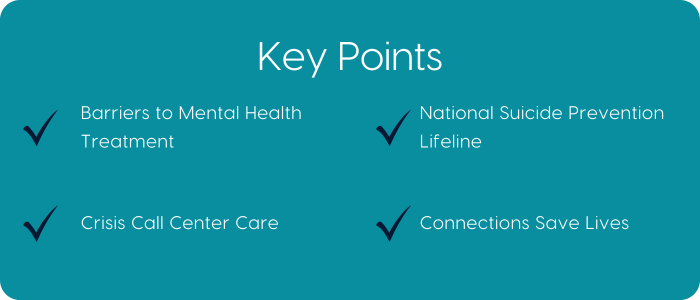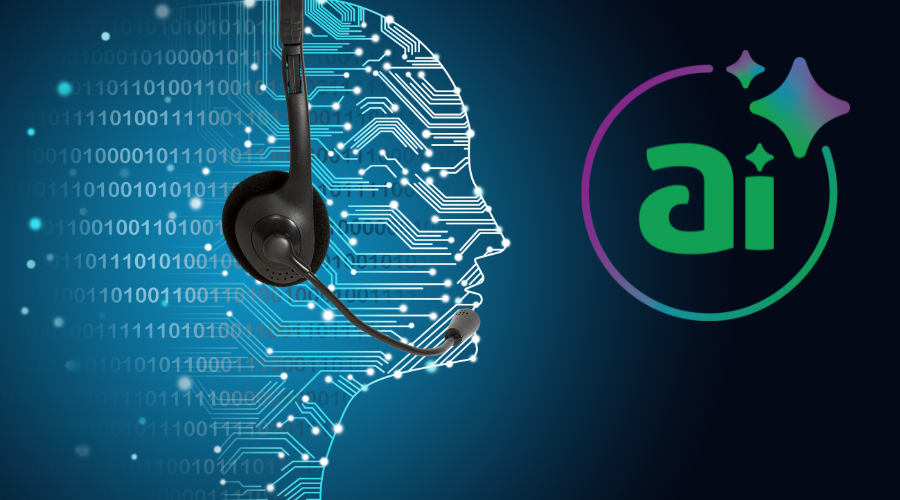The term “mental health” refers to the condition of a person’s emotional, psychological, and social well-being. The state of one’s mental health affects how they feel, think, and behave. At times, an individual may experience one or more adverse mental health concerns. Mental health issues are common and treatable. According to the National Alliance on Mental Illness (NAMI), an estimated 23.1% of U.S. adults, or about 59.3 million people, experience mental illness in any given year.
It is crucial that people have access to mental health services. Mental illness is a disease, and sometimes, it may cause an individual to experience behavior that poses an immediate threat to themselves, to people around them, or to property. Unfortunately, research indicates that roughly two-thirds of people in the United States with diagnosable mental health conditions do not receive services.
Technology is reducing barriers to mental health treatment by creating a network of care. Call centers provide a critical service in this endeavor by using state-of-the-art communication systems to improve mental health care.

Barriers to Mental Health Treatment
Many studies and surveys have been done to uncover why the majority of Americans with mental health conditions do not receive care. The most common reasons discovered include financial hardships, racial and cultural differences and misunderstandings, lack of mental health services, and social stigma.
To better understand how these challenges are experienced in the real world, below are some ways people who live in rural communities may experience these obstacles:
- Transportation hardship. Access to care may require time off work and lost wages for long-distance travel and/or coordinating and paying for transport if a reliable vehicle isn’t available (low-cost public transport usually isn’t an option).
- Absence of culturally competent care. In 2020, approximately 24% of rural Americans identified as people of color, with over 10 million rural residents identifying as Black, Hispanic/Latino, American Indian/Alaska Native, Asian, or Native Hawaiian/Pacific Islander. Multiple studies indicate that racially and ethnically diverse populations contend with language and cultural barriers when accessing healthcare.
- Shortage of mental health professionals. Rural and low-income areas have the lowest percentage of behavioral health workers in the United States due in part to billing restrictions and low provider reimbursement rates, especially for Medicaid – which has higher enrollment in rural populations.
- Lack of anonymity. It can be difficult to maintain privacy in close-knit, rural communities. Many people choose to suffer with their condition(s) instead of seeking help because of the social stigma associated with mental illness.

Crisis Call Center Care
Telehealth is helping to overcome barriers and increase access to mental health care. Crisis call centers, which are available twenty-four hours a day, seven days a week, connect people experiencing mental health events with behavioral health professionals.
Many call centers offer online chat, text communication, and real-time interpretation services (including American Sign Language via video chat). Some specialized centers even have software designed to dispatch mobile crisis teams to people needing more intense treatment. These integrated technologies enable people to receive professional care in person, in the privacy of their own homes.
Call center managers can track outcomes using reporting technology and see if and when a caller receives services from a mental health facility for ongoing care.
National Suicide Prevention Lifeline
Call centers are a critical part of the system that makes up the National Suicide Prevention Lifeline (NSPL) network. This kind of crisis service system can provide Level 5 “Close and Fully Integrated” care by implementing an integrated suite of software applications. According to the NSPL, the components of this system are:
- Status Disposition for Intensive Referrals: A comprehensive list of people waiting for care, including their wait times and location information.
- 24/7 Outpatient Scheduling: Crisis call center staff can access to electronic appointment information.
- Shared Bed Inventory Tracking: Access to information about how many beds are available in a particular area or state, where they are located, and what type of care a person can receive at that location.
- High-tech, GPS-enabled Mobile Crisis Dispatch: Information about the location of the closest available mobile care team.
- Real-time Performance Outcomes Dashboards: Provide analytics information regarding operator workflows and performance to indicate the speed at which people are receiving help.

Connections Save Lives
Studies unequivocally show that integrated communication technology is providing better access to mental health treatment. Current health technology solutions are being enhanced with the use of mental health apps for more accurate data that leads to customized care. Telehealth technology provides a clear path to help coordinate this care and improve mental health outcomes.
Leveraging communication and health technologies connects individuals, families, and communities to mental health care. This creates a network of support to build a stronger and more mentally healthy society.





